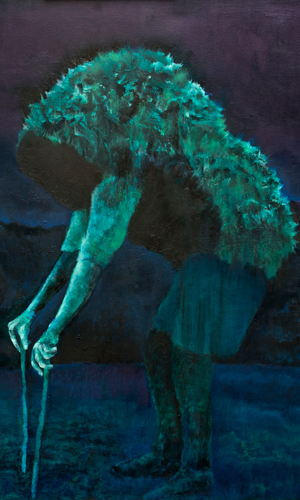Bruno Vilela
(1977, Recife, Brasil)
Dotadas de certo mistério, as figuras de Bruno Vilela parecem se privar do nosso olhar; escondem-se em mata densa e nos observam ao longe. Como na tela Erga-se, na qual seu rosto e outros elementos que lhe atribuem características físicas parecem terem sido rasgados, dando lugar à penumbra que nos recorda as cores de uma trilha noturna: verde musgo, azul cobalto, tons de vermelho tímido, apagado pela luz noturna. Essas figuras se entregam à imaginação do caminhante solitário, que observa a floresta e suas sombras, e imagina nelas possíveis ameaças – bichos, pessoas, figuras fantásticas. A relação onírica que existe entre luz e escuridão (ver e não ver) também aparece em Voo cego e Big bang, traduzindo o universo fantasioso das pinturas em gesto. Em Voo Cego, a luz possibilita a visão e apaga a fotografia, deixando para o tato cego ler outras possíveis imagens (dessa vez, da literatura); em Big bang, tiros de fuzil sobre placa de alumínio produzem pequenos pontos luminosos, desenhando constelações imaginárias – um sistema de cartografia milenar e fundamental para viagens noturnas, quando o único guia em terra era o próprio céu. É nesse universo imaginário que Vilela cria uma espécie de dessemelhança das coisas que nos circundam. Afinal, nem tudo o que há no claro mantém-se igual no escuro.
Bearing a certain mystery, Bruno Vilela’s figures seem to evade our gaze; they hide in the forest thicket and observe us from afar. Like in the canvas Erga-se, his face and other elements that give him physical characteristics seem to have been ripped away, giving way to the shadows that recall a nocturnal trail: green moss, cobalt blue, shy tones of red, dimmed by the nocturnal light. These figures yield to the imagination of the lone walker, who observes the forest and its shadows, and imagines possible threats – animals, people, fantastic figures. The oneiric relationship that exists between light and darkness (seeing and not seeing) also appears in Voo cego [Blind Flight] and Big bang, translating the fantastic universe of the paintings into gestures. In Voo Cego, the light allows for vision and erases the photography, allowing the blind sense of touch to read other possible images (this time, from literature); in Big bang, shots from a rifle on aluminum plate produce small luminous points, drawing imaginary constellations – an age-old system of cartography and fundamental for nocturnal voyages, when the only guide on earth was the sky. It is in this imaginary universe that Vilela creates a sort of unlikeness of the things that surround us. After all, not everything in the light looks the same in the dark.
Isabela Rjeille

